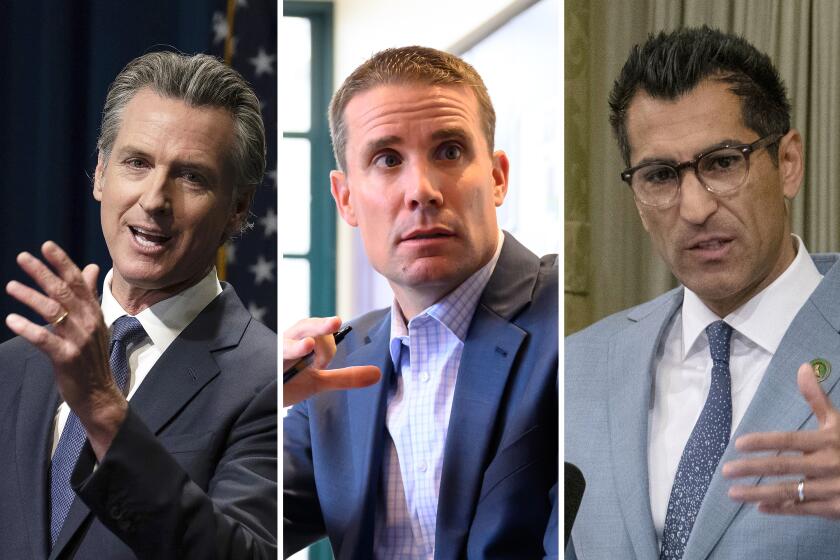
- Share via
President Trump’s executive order calling on the Department of Veterans Affairs to house thousands of homeless veterans on its West Los Angeles campus by the end of his term promises the relief veterans have been seeking in federal court for more than a decade.
But the May 9 order gave no insight into how the president planned to overcome hurdles that have long stymied the dream of a vibrant veteran community on the 388-acre property, which was donated to the U.S. government in 1888 as a home for disabled soldiers.
Trump’s order called for establishing a National Center for Warrior Independence — with the capacity to house about 6,000 — “in which homeless veterans in the Los Angeles metropolitan area and around the nation can seek and receive the care, benefits, and services to which they are entitled.”
Veterans and their advocates, who have been critical of the VA’s management of the grounds, welcomed the announcement as a presidential endorsement of their cause, but generally reserved judgment over what they expect it to accomplish. Some were openly skeptical.
“If this had come from any other president, I’d pop the champagne,” said Rep. Brad Sherman (D-Sherman Oaks), whose district includes the West Los Angeles campus. Trump, he said, follows up on “one out of 10 things that he announces. You just never know which one. You never know to what extent.”

Among the questions not addressed in the order: How much would such an ambitious project cost? Is there enough room for that much housing? And how might the president’s vision fit in with projects already underway to build 1,200 housing units or a judge’s order, now under appeal, for at least 1,800 more?
Within the order, Trump called on government agencies to “ensure that funds that may have been spent on housing or other services for illegal aliens are redirected” to the VA, a strategy Sherman dismissed as show.
“He just says that he loves veterans and hates illegal immigrants,” Sherman said. “We knew that.”
Based on current construction costs, Sherman estimates that the housing would conservatively cost $3.3 billion, a figure he said would require a congressional authorization. Sherman contrasted that potential outlay with the administration’s plan to cut spending by reducing the VA staff.
“Show me the money and promise me that you’re not going to have cuts to veterans’ healthcare,” he said.
Concurrent with the order, VA Secretary Doug Collins issued a statement promising to improve healthcare through shorter wait times, extended hours and more telemedicine. To do so, he said, the VA would become “the most accountable agency in the entire federal government” by holding employees accountable when they “fall short of the mission.”

A spokesman declined to provide additional detail but said further announcements regarding implementation would be forthcoming. The order requires the VA to produce an “action plan” in 120 days.
Aside from the question of funding Trump’s goal, a major rethinking of current plans for the property — actually two independent plans derived from two lawsuits — would probably be needed to accommodate 6,000 new residents.
A 2016 master plan, drawn up under a settlement of the first case and updated in 2022, lays out a footprint for adding 1,200 units of new housing through a combination of renovating existing buildings and erecting new ones. Close to a decade later, only 448 of those units are completed, a number the VA estimates will climb to 730 next year.
Last year, in a second lawsuit prompted largely by that slow progress, U.S. District Court Judge David O. Carter ordered the VA to come up with a plan to produce as many as 1,800 units of permanent housing and 750 of temporary. Carter conducted several hearings poring over every parcel with his expert witnesses to find space for them. To get close required Carter to assume the buildings would be four stories, the same height as many buildings on the campus. Doubling that would probably require more stories.
“Whether there is room for 6,000 units is solely a matter of the allocation of land and the density associated with building,” one of those witnesses, developer Steve Soboroff, said in an email.
Trump’s order implies, but again does not explicitly say, that the VA could reclaim land leased to UCLA and the private Brentwood School for athletic facilities. Carter’s ruling nullified those leases, but then oversaw an agreement allowing the K-12 school to continue using its facilities with expanded access for veterans. The VA rejected the agreement.
Sherman said 1,800 units would be a realistic goal assuming the Republicans do not act on proposals to cut back two of the key pillars of the financing model — veteran rental subsidies and tax credits. He calculated that a third of the cost would come from bank loans secured against federal housing vouchers, a third from tax credits and a third from the $350 million allocated to the West Los Angeles campus through the 2022 legislation known as the PACT Act.
The timeline would not be so realistic, said Anthony Allman, executive director of Vets Advocacy, a nonprofit created to monitor the settlement of the first lawsuit. To build 6,000 new units, or even 1,800, by 2028 using the same financing model would far exceed the VA’s capacity based on its past performance, he said.
But that’s not what he thinks the order requires. Allman sees another possible interpretation of the order would bear less on land use and financing and instead require a shift in the VA’s housing strategy.
“As I read the executive order, it’s not 6,000 units, it’s 6,000 veterans being served by 2028,” Allman said.
In his statement, Secretary Collins said the goal is “to turn the campus into a beacon of hope and a destination for homeless Veterans from across the nation who can travel there to find housing and support and start their journey back to self-sufficiency.”

That could mean that veterans would come to L.A. for specific services such as medical procedures, rehabilitation or job training and reintegration, then return home somewhere else.
“Historically, we’ve always talked in terms of permanent supportive housing, but this 6,000 number leads me to believe we might be talking something more transitional in nature,” Allman said.
Potentially, he said, the VA could purchase and quickly install new modular units — bypassing the complicated tax credit financing and infrastructure upgrades that have slowed the development so far.
That course would align with Carter’s order requiring the VA to provide up to 750 units of temporary supportive housing. Acting on the judge’s behalf, Soroboff and partner Randy Johnson had lined up contractors to produce the first 100 in place by this spring when the VA appealed the judgment. The 9th Circuit Court of Appeals heard arguments last month but has not issued a decision.
Allman said he’s counting on the action plan required by the order to clarify some of the unknowns.
“This is speculation,” he said. “We just don’t know.”
Whether in permanent or temporary homes, the possible arrival of thousands more veterans to the property puts new focus on long-simmering disputes over plans for a town center with commercial and social amenities and a job training center, said Rob Begland, a recently termed-out member of the Veterans and Community Oversight and Engagement Board, a panel set up after the 2015 settlement to advise the VA on development.
After four years on the board, Begland protested in an April letter to the chairmen of the Senate and House Veterans Affairs Committees that the VA had “repeatedly disregarded sensible advice.”
“The original master plan called for a town center, vocational training and housing,” Begland said in an interview. “The only thing we’ve seen progress on is housing and the progress on housing has been inadequate.”
Begland traces the failure to the VA’s refusal to ask Congress for the funds to implement the plan.
“Instead, it took the path of least resistance and put the burden on private developers as much as it could” through leases, he said.
For the record:
10:09 a.m. May 19, 2025An earlier version of this article incorrectly named the development partnership working with the VA as the Vets Collective. It’s the Veterans Collective.
The development partnership, the Veterans Collective, relied on tax credit financing, a cumbersome process that not only can add years to a project but also only funds housing. It has no plans to build a vocational center, and its plan for the town center is to use the ground floor of four newly constructed four-story residential buildings.
Begland sees the executive order as an opportunity to refocus on the original intent of the 2016 master plan. That would require both an additional funding source and new leasing authority, Begland said.
“I do think the administration will have to work with Congress to implement this,” he said.
That’s another unknown.
“It’s hard to look at this as anything other than aspirational,” Sherman said. “I appreciate the spirit that Trump was tapping into when he issued the executive order. Now we have got to get the money.”
More to Read
Sign up for Essential California
The most important California stories and recommendations in your inbox every morning.
You may occasionally receive promotional content from the Los Angeles Times.














